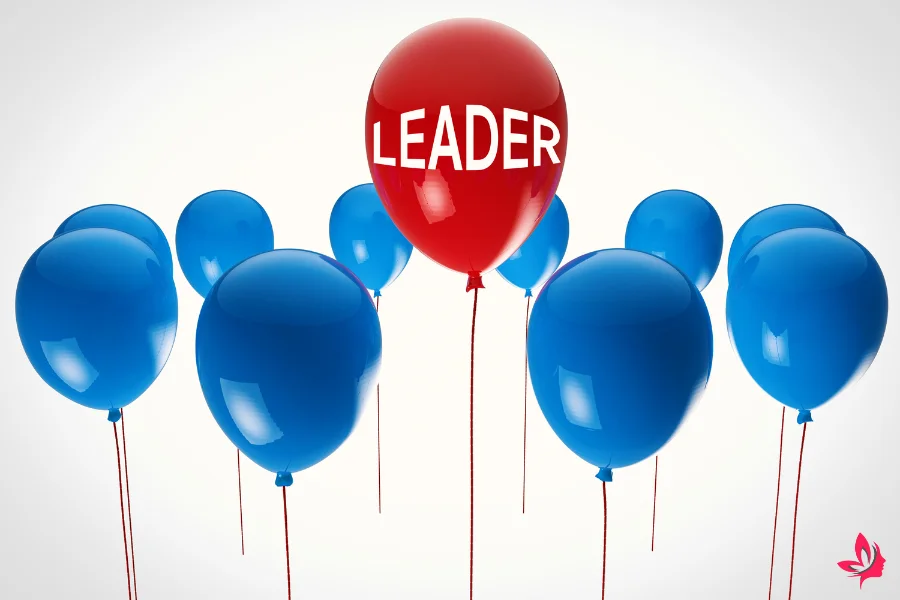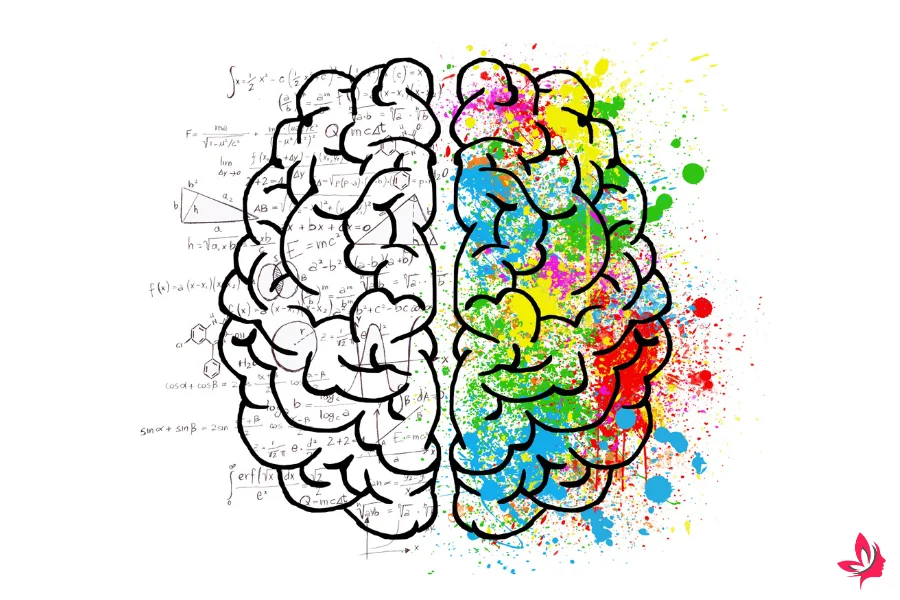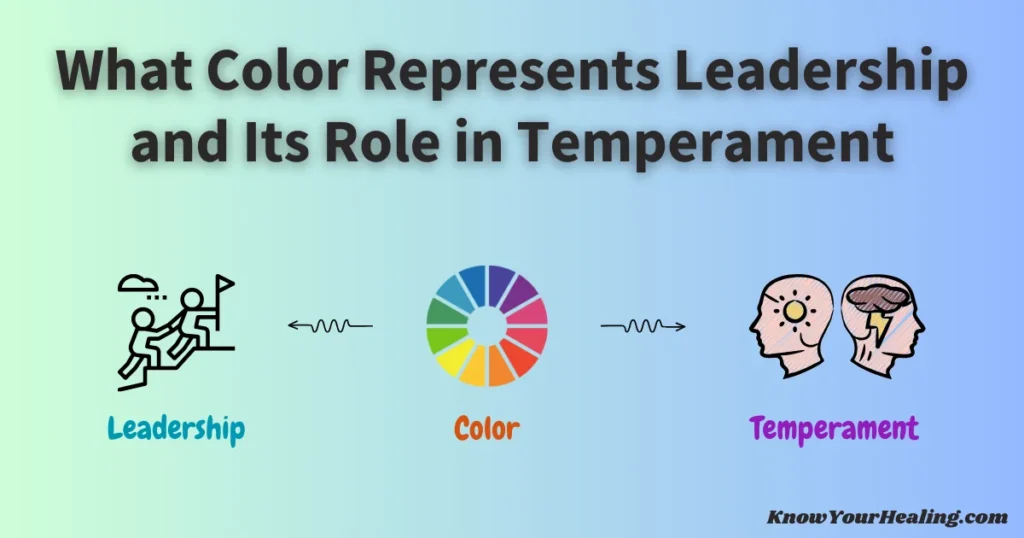What color represents leadership? Different colors can symbolize various leadership styles and influence personalities.
Red is often associated with leadership due to its association with assertiveness, drive, and a strong sense of direction.
For instance, individuals with a red leadership style are often bold and decisive, making them natural leaders.
Each color can influence temperament. For instance, blue is linked with calm and consistency, traits valuable in times of change or stress. Meanwhile, yellow might symbolize creativity and enthusiasm, encouraging innovation and a positive atmosphere in leadership contexts.
Understanding these color connections can help identify leaders’ strengths and areas for growth.
Understanding Color Psychology in Leadership

Color psychology plays a vital role in leadership. It influences how leaders communicate and how others perceive their styles. It also affects team interactions and decision-making processes.
Linking specific colors to leadership traits can help identify and enhance distinct leadership qualities.
The Impact of Color on Team Members’ Dynamics
Different colors can significantly affect how team members interact with one another.
For example, red, often seen as a color of passion and energy, can encourage high energy and assertiveness in team settings. It may boost confidence but raise blood pressure, highlighting its intense nature.
In contrast, blue is associated with calmness and stability and fosters a supportive environment. Leaders using blue may help team members feel more at ease, promoting creativity and cooperation.
These color dynamics are crucial in crafting an effective work atmosphere that aligns with core values. By understanding these color influences, leaders can better align their strategies with their team’s needs.
How Quick Decisions Are Influenced by Color Choices
Color choices can be surprisingly impactful when making quick decisions.
Bright colors like orange and yellow are often linked to stimulating mental activity and enthusiasm. They encourage quick thinking but may also lead to impulsive decisions.
Conversely, dark colors such as dark blue and purple can promote deep thinking and careful planning, traits necessary for sound decision-making in high-pressure scenarios.
Strong leaders recognize the significance of these color influences and adjust their approach accordingly. Using color psychology to guide quick decisions can lead to more informed outcomes, enhancing overall leadership effectiveness.
Exploring Leadership Symbols and Their Color Associations
Leadership symbols frequently incorporate specific color associations that convey particular messages.
| Color | Associations | Description |
|---|---|---|
| Black | Prestige, Authority, Elegance | Black is a prestigious color symbolizing sophistication, often seen in black tie and black Mercedes |
| Green | Renewal, Growth | Green symbolizes renewal and growth, fostering collaborative leadership and team support |
| Yellow | Warmth, Optimism | Yellow conveys warmth and optimism, making it ideal for inspirational leadership |
Leaders aware of these color-symbol associations can use them as powerful tools to communicate their leadership vision and strengthen their symbolic image.
Primary Colors and Their Leadership Meanings

Primary colors play a significant role in representing leadership styles. These colors, such as dark blue and red, carry different symbolic meanings that affect team dynamics, decision-making, and collaboration.
The Significance of Dark Blue in Strong Leadership
Dark blue is often considered prestigious, representing trust, responsibility, and authority. Leaders who favor dark blue tend to be reliable and consistent.
This color is often associated with business leaders and the financial world, symbolizing stability and control.
Dark blue is used in office designs in a corporate setting to communicate professionalism and confidence. It encourages team members to focus on common goals and enhances communication, making it effective for strong leaders who aim to foster a sense of security and trust.
Red Leaders vs. Blue Leaders: A Color Comparison
Below is a comparison table between red and blue leaders:
| Leader Type | Characteristics | Leadership Style |
|---|---|---|
| Red Leader | Bold, assertive, passionate | Make quick decisions and inspire action, symbolizing intense emotions and forward momentum. |
| Blue Leader | Analytical, calming | Prefer careful planning and measured responses. |
The differences in red to blue leaders highlight how color psychology affects leadership styles and team members’ interactions.
The Role of Warm Colors in Creating a Collaborative Environment
Warm colors like orange and yellow are key elements in creating a collaborative environment.
Orange leaders are generally enthusiastic and engaging, easily uniting different types of people for a common goal. These colors promote mental activity and a positive atmosphere that encourages creative teamwork.
Yellow produces optimism and clarity, which can inspire and guide teams towards innovative solutions.
By incorporating warm colors in leadership environments, leaders can facilitate an inclusive and dynamic space where collaborative leader thrive.
These colors are especially effective in settings focused on creativity and innovation, reinforcing the importance of diverse approaches in leadership.
The Emotional Impact of Colors on Leadership Styles

Color significantly shapes leadership styles by influencing decision-making, emotional responses, and personality traits. Color psychology reveals how different hues can affect leaders and their impact on team members.
How Different Colors Affect Mental Activity and Decision-Making
Color directly influences leaders’ mental activity and decision-making.
Bright colors like yellow and red can stimulate mental processes, making leaders more efficient in quick decisions during high-pressure situations.
Conversely, darker shades, such as dark blue or darker green, foster calmness and contemplative thinking, which suits operational leader who rely on data-driven insights.
This highlights color associations in professional settings, where specific hues may promote more effective leadership practices.
The Influence of Color on Personality Styles and Core Values
Different colors often align with particular personality styles and core leadership values.
For instance, blue is common in leadership symbols, representing trust and integrity, aligning with blue leaders who are compassionate and committed to a common goal.
Green often signifies growth and balance, representing a green leader focused on nurturing their team.
Leaders who select certain colors as their favorite may display traits associated with these hues, reflecting their personality temperament and shaping how they relate to team members.
Exploring the Color of Passion: Red and Its Leaders
Red is a very emotionally intense color, often symbolizing passion, energy, and determination.
Red leaders are typically bold, assertive, and focused on achieving goals. This color of passion is often seen in charismatic leaders who inspire those around them through their enthusiasm and drive.
However, red can also raise blood pressure, making it ideal for leaders handling quick, decisive challenges but less suitable for servant leadership, where empathy and patience are valued.
Color Associations and Leadership in Different Contexts

The influence of color in leadership is diverse, with different colors conveying varied symbolic meanings. In various settings, the choice of colors can affect leaders’ perceptions of strength, trust, and empathy.
The Use of Bright Colors in Business Leaders’ Branding
Business leaders frequently use bright colors to stand out and convey energy and creativity.
For instance, red is often associated with power and passion, making it a favorite for bold brands seeking to demonstrate confidence and dynamism. Orange is also popular among leaders who wish to exude enthusiasm and warmth, appealing to audiences with its friendly vibe.
Meanwhile, yellow quickly captures attention, symbolizing optimism and insight, which can encourage quick decisions in fast-paced environments.
These bright colors can influence team members by creating an invigorating atmosphere.
Charitable Organizations and Their Favorite Color Choices
Charitable organizations often choose colors that evoke trust and compassion, such as blue and green.
Blue is widely used due to its association with calmness and reliability, making it a suitable choice for organizations focusing on community support and mental activity.
Meanwhile, green represents growth and harmony, aligning with the missions of environmental and health-focused charities.
Charities use these colors to project a sense of integrity and approachability. They aim to connect with the public through empathy and collaboration, which are central to servant leadership.
The Symbolic Meaning of Colors in the Financial World
In the financial world, colors convey prestige and stability.
For instance, dark blue is often seen in corporate settings due to its association with depth and stability, appealing to firms looking to cultivate trust and competence.
Black is another frequent choice, symbolizing elegance and authority, crucial in high-stakes financial deals.
Dark green represents prosperity and wealth, making it suitable for institutions focused on growth and profitability.
These colors reflect the seriousness and professionalism expected in financial transactions.
Practical Applications of Color in Leadership

Color is critical in leadership because it influences mood, behavior, and communication. Leaders can use color strategically to reinforce their presence, guide new team members, and make operational decisions.
Office Designs: Using Color to Enhance Leadership Presence
Incorporating different colors into office design can enhance leadership visibility.
Bold colors like dark blue and red, often considered prestigious and powerful, can significantly impact.
Dark blue, often associated with authority, can help create a sense of calm and focus. This is why it’s frequently used in executive meeting rooms and leadership offices.
Red, a very emotionally intense color, can stimulate quick decisions. It’s helpful in environments where urgency and energy are required.
Additionally, warm colors can make the space feel more inviting and encourage collaboration among team members.
The Best Color Choices for Operational Leader
Operational leaders could benefit from color choices that emphasize focus and efficiency.
Green and blue are generally calming and can help reduce stress, fostering a productive atmosphere. Green is particularly effective because it is associated with stability and growth.
Blue, significantly lighter shades, can improve productivity by boosting mental activity without increasing blood pressure.
How Color Theory Can Guide New Leaders in Their Roles
Understanding color theory gives new leaders powerful tools for effective communication and team dynamics.
By selecting colors that align with their personal views and leadership styles, new leaders can better connect with different types of people.
Yellow is a favorite color for its optimistic and energetic vibes, making it ideal for inspiring teams.
Leaders who prefer inspirational leadership often gravitate towards vibrant colors like orange and yellow to motivate and encourage collaboration.
Meanwhile, servant leaders can use soft colors like light purple to imply approachability and warmth.
Such color choices help establish a leadership presence that resonates with the team’s core values and goals.
Final Thoughts
What color represents leadership best can depend on individual perspective and context.
Different colors can symbolize various leadership traits. For instance, red often means a strong, decisive style, while blue may suggest a calm and steady approach.
Each color can relate to personality and temperament. People with certain temperaments might feel drawn to or display leadership styles in line with certain colors.
For example, a leader with a yellow temperament might be more lighthearted and open to change.
Colors enhance understanding of leadership styles, promoting better communication and teamwork.
Recognizing these color associations can help leaders adapt to different situations and connect more effectively with their team members.
Key Takeaways
- Red: Represents a strong, directional leadership style.
- Blue: Suggests calm, consistent leadership.
- Yellow: Associated with an energetic, open approach.
- Color: Enhances understanding of temperament and leadership.
Color symbolism informs leadership approaches, offering insights for more effective communication and team unity.
Frequently Asked Questions
Different colors can symbolize leadership, each linked to distinctive traits and characteristics.
These colors provide insight into personality strengths such as motivation, energy, and empathy.
What are the colors of leadership?
Leadership is often associated with red, blue, green, yellow, and purple colors. These colors represent leadership qualities such as passion, calmness, balance, optimism, and wisdom.
What symbolizes leadership?
Leadership is symbolized by confidence, decisiveness, and the ability to inspire others. Colors like red often symbolize these attributes due to their association with energy and passion.
What colors do leaders wear?
Leaders often wear navy blue, black, and grey. These colors convey authority, professionalism, and reliability, making them popular choices in leadership settings.
What is the green color of a leader?
The green color in leadership symbolizes balance and stability.
Individuals associated with green may exhibit qualities like being supportive, understanding, and focused on growth and harmony.
What are the 4 colour leadership?
The four-color leadership model typically includes red, blue, green, and yellow. Each color reflects leadership qualities, such as ambition, empathy, stability, and enthusiasm.
What is the color of leadership aura?
The color of a leadership aura may vary, but it is often gold or yellow. These colors represent wisdom, success, and optimism in a leadership context.
Why is red the color of leadership?
Red is seen as a leadership color because it reflects energy, passion, and assertiveness.
Leaders with red personalities often take charge and are driven by their goals.
What color represents empowering?
Empowering is often represented by the color yellow. Yellow symbolizes optimism, creativity, and the ability to uplift and encourage others.
What is the purple leadership color?
Purple represents wisdom and vision in leadership.
Leaders who resonate with purple are often seen as insightful, innovative, and forward-thinking.
What is the 4 color leadership test?
The four-color leadership test helps identify dominant traits based on color personality types.
It provides insights into how individuals lead and relate to others in various situations.




